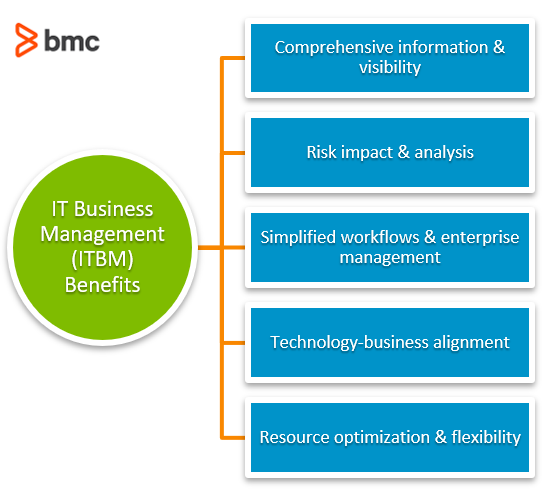IT Business Management (ITBM), sometimes known as IT Enterprise Management, is an emerging concept in enterprise IT. Is it a different approach, or just old flavors by a new name?
Let’s take a look.
What is IT business management?
IT business management (ITBM) refers to the practice of controlling and conducting business information, IT systems, IT-enabled operations, services, and resources in an enterprise organization.
ITBM adopts lean methodologies and contributes to the domains of:
- Application portfolio management (APM)
- Financial management
- Project management
- Agile delivery execution
An ITBM solution suite likely performs two high-level activities:
- Integrates a set of feature-rich IT management systems across these domains
- Provides a high-level understanding of business, information, and IT resources used to perform daily business operations
The resulting visibility could enable organizations to optimize and control these resources, using predefined workflows according to the latest Agile and Lean framework methodologies.
Importantly, as we’ll see by the article’s end, ITBM as a product is not fully developed. The market here is nascent, one with limited real-world solutions marketed under this term. But, many companies already offer IT platforms that offer these solutions—just under more common names.

Top business benefits of ITBM
There are several reasons that enterprises might elect this approach. Let’s take a look.
Comprehensive information & visibility
As organizations increasingly rely on technology, new risks and responsibilities are exposed to the organization at all hierarchical levels.
Decision making around business operations and investments require a thorough analysis of all domains and departments of the organization. This analysis requires organizations to integrate all sources of information and process data in real time.
An information repository that tracks all assets, services, and apps, updated in real-time, provides end-to-end visibility into all financial workflows. As a result, organizations can better manage and optimize investments, especially in DevOps organizations that thrive on rapid provisioning of IT resources at various stages of the software development lifecycle (SDLC).
Risk impact & analysis
Risk management is integral to an IT service management organization. When data lies across islands of siloed data repositories, projects, and technologies, implementing and controlling risk is a significant challenge.
Risk management follows its own lifecycle and is adopted as a continuous process. The key elements of the process include identifying, prioritizing, and monitoring of various risk vectors.
An ITBM solution keeps track of resources added, consumed, or removed to the service library. The catalog can be configured to stringent governance policies that take into account potential risk behaviors such as:
- Shadow IT
- Anomalous consumption of IT services
Similar capabilities can be used to track and control information assets and other resources, thereby reducing the risk impact to IT-enabled business organizations that otherwise rely on a variety of siloed technology solutions.
Simplified workflows & enterprise management
Automating repetitive tasks, configurations, and workflows helps organizations get more work done in resource-constrained settings. As organizations invest in a variety of technology solutions and run services on multi-cloud hybrid IT environments, they need to simplify the Agile and DevOps implementation process for daily business and IT operations.
How can organizations simplify Agile and DevOps workflows?
ITBM technologies help to:
- Synchronize teams
- Simplify financial workflows
- Manage coherent projects and assets collectively
- Track the resources invested across all projects
As a result, organizations can orchestrate efforts with complete knowledge of the available assets and simplify the wider enterprise project management chain.
Technology-business alignment
A critical success factor of digital transformation is the ability of ITSM organizations to align technology investments with business goals. Business organizations, the market landscape, and enterprise IT evolve continuously and require reliable ways to identify needs, manage performance, and deliver results.
The case for an ITBM solution lies in the capability of connecting IT to ROI through metrics insights based on holistic and real-time information. Organizations need to know where and how they can eliminate waste processes and expenses.
ITBM technologies typically feature an all-inclusive project and portfolio lifecycle management capabilities that make it easier to leverage data driven ITSM frameworks. As a result, every process workflow and decision can be aligned to meet organizational goals based on agreed metrics and data-driven insights.
(Read more about IT/business alignment.)
Resource optimization & flexibility
Digital transformation is a paradigm shift for many industry verticals and organizations that lag behind. These organizations often struggle to optimize the supply of IT resources against cost or ability to scale operations rapidly.
One of the important contributing factors is the lack of agility: the ability to efficiently change the culture, business strategy, and technologies or techniques used to conduct business operations.
One solution to this challenge is to anticipate change and provision the flexibility to change upfront. While transformation projects can become increasingly complex, staying on top of all assets and knowing exactly how the resources are being spent is a simple way of achieving this goal but requires end-to-end visibility and control into resource procurement, delivery, and utilization.
ITBM technologies can play a crucial role in this context, providing a unified and holistic interface to take control of all information and asset workflows within the financial and application portfolio management domains.
The ITBM potential isn’t realized (yet)
A caveat on ITBM.
Despite the value propositions, the ITBM technology space is still far from ready. The industry has yet to establish definitive standards as to exactly which technology capabilities constitute a holistic ITBM solution.
Vendors including ServiceNow offer technologies specifically marketed as ITBM, whereas other vendors may offer a set of technologies with similar capabilities without specifically marketing them as an ITBM product suite.
Related reading
- BMC Business of IT Blog
- BMC Service Management Blog
- What Is Enterprise Service Management? (ITSM for the Rest of Us)
- Project Portfolio Management: Comparing PPM to Project & Program Management
- Application Performance Management in DevOps
- ITSM vs BRM vs Agile: How Service, Business Relationship & Product Management Work Together







